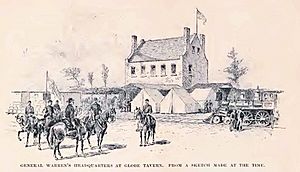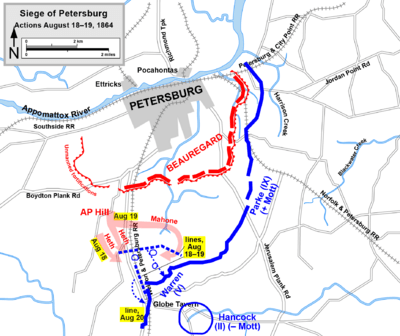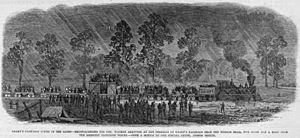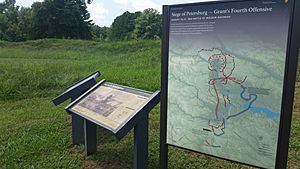Battle of Globe Tavern facts for kids
Quick facts for kids Battle of Globe Tavern |
|||||||
|---|---|---|---|---|---|---|---|
| Part of the American Civil War | |||||||
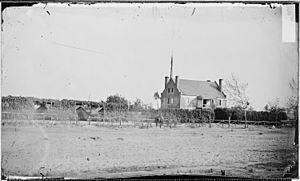 A photograph of Globe Tavern by Mathew Brady taken between 1860 and 1865. |
|||||||
|
|||||||
| Belligerents | |||||||
| Commanders and leaders | |||||||
| Gouverneur K. Warren | A. P. Hill P.G.T. Beauregard |
||||||
| Strength | |||||||
| 20,000 | 14–15,000 | ||||||
| Casualties and losses | |||||||
| 4,296 251 killed 1,148 wounded 2,897 missing/captured |
1,620 211 killed 990 wounded 419 missing/captured |
||||||
The Battle of Globe Tavern, also known as the Second Battle of the Weldon Railroad, was a big fight during the American Civil War. It happened from August 18 to 21, 1864, near Petersburg, Virginia. This battle was the second time the Union Army tried to cut off the important Weldon Railroad. This railroad was a key supply line for the Confederate city of Petersburg.
Union forces, led by Major General Gouverneur K. Warren, managed to destroy parts of the railroad tracks. They also fought off strong attacks from Confederate troops. These Confederate forces were commanded by General P.G.T. Beauregard and Lieutenant General A.P. Hill. This battle was the first time the Union won a clear victory in the long siege of Petersburg. After this battle, the Confederates had to carry their supplies about 30 miles (48 km) by wagon. This was because the Union army now controlled part of the railroad.
Why the Battle Happened
The city of Petersburg was under a long attack, called a siege. The Union Army's leader, Lieutenant General Ulysses S. Grant, wanted to cut off all the railroads that brought supplies into Petersburg. These supplies were vital for Confederate General Robert E. Lee's army and the Confederate capital, Richmond.
One of the most important supply lines was the Petersburg and Weldon Railroad. This railroad went south to Weldon, North Carolina. From there, it connected to another railroad that led to Wilmington, North Carolina. Wilmington was the Confederacy's last major port. Cutting this railroad would make it very hard for the Confederates to get food and weapons.
In June, the Union's II Corps had tried to destroy a small part of this railroad. But they were pushed back by Confederate forces. In August, Grant planned another attack on the Weldon Railroad. He chose the V Corps, led by Major General Gouverneur K. Warren, to lead this attack. Other Union units also helped.
At the same time, General Robert E. Lee was busy fighting north of Petersburg. So, General P.G.T. Beauregard was in charge of the Confederate defenses at Petersburg. Lieutenant General A.P. Hill commanded Beauregard's main infantry troops.
President Abraham Lincoln sent a message to General Grant, encouraging him to keep fighting hard:
I have seen your despatch expressing your unwillingness to break your hold where you are. Neither am I willing. Hold on with a bulldog grip, and chew and choke as much as possible.
Grant felt that President Lincoln was very determined.
The Battle Begins
On August 18, 1864, the Union V Corps started moving south. It was raining, and the roads were muddy. They pushed past Confederate guards and reached the railroad at Globe Tavern around 9 a.m.
Some Union soldiers immediately began to tear up the railroad tracks. Other soldiers formed a battle line to stop any Confederate attacks from the north. Around 1 p.m., these Union soldiers met Confederate troops. General Warren ordered more Union troops to move forward to try and get around the Confederate left side.
Confederate General A.P. Hill sent two brigades of soldiers to meet the Union advance. Around 2 p.m., the Confederates launched a strong attack. They pushed the Union troops back close to Globe Tavern. But Warren's men fought back and got their ground back. They then dug trenches to protect themselves for the night. During the night, a Union soldier named Lieutenant William Taylor went on a dangerous scouting mission. He was captured by Confederate forces, but his bravery was later recognized with the Medal of Honor.
Fighting Continues
More soldiers arrived during the night. The Union IX Corps joined Warren's forces. On the Confederate side, Major General W.H.F. "Rooney" Lee's cavalry and three infantry brigades arrived. On August 19, there was mostly light fighting because of the heavy rain.
In the late afternoon, Confederate Major General William Mahone launched a surprise attack. He found a weak spot in the Union line and rushed into their rear. This caused many Union soldiers to panic and run. Their commander, General Crawford, tried to rally them but was almost captured himself. The Confederates took hundreds of Union soldiers as prisoners.
While Mahone attacked the Union right, another Confederate general, Heth, attacked the center and left. But the Union soldiers there held their ground easily. The Union IX Corps then counterattacked. There was fierce hand-to-hand fighting until it got dark.
Heavy rains stopped any major fighting on August 20. That night, General Warren moved his Union troops back about two miles (3 km). They built new defenses that connected to the main Union lines. On August 21, the weather was fair again. The Confederates attacked at 9 a.m., but their attacks were not successful against the strong Union defenses. They suffered heavy losses. By 10:30 a.m., the Confederates pulled back. This left several miles of the Weldon Railroad in Union hands.
What Happened Next
We have just repulsed an attack of Mahone's division from the west of the railroad. Whipped it easily.
The Union army had 4,296 soldiers killed, wounded, or captured. The Confederates had 1,620 soldiers killed, wounded, or captured. The Confederates lost a very important part of the Petersburg Railroad. This meant they had to use wagons to carry supplies a long distance to Petersburg.
This battle was the Union army's first clear victory during the long siege of Petersburg. They achieved a major goal by cutting the railroad. However, General Grant wasn't completely happy. He felt that when the enemy attacked and was pushed back, his troops should have chased them more aggressively.
To get full control of the railroad, Grant soon sent more Union troops to destroy the Petersburg Railroad further south. This led to another battle called the Second Battle of Ream's Station a few days later.
See also
 In Spanish: Batalla de Globe Tavern para niños
In Spanish: Batalla de Globe Tavern para niños


